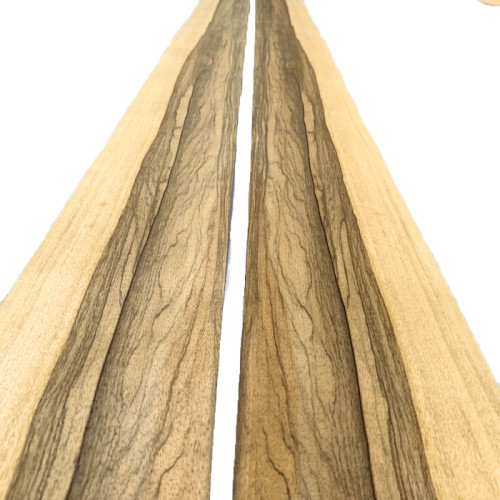
Black Limba Veneers 260 x 17 cm
Black Limba Veneers 260 x 17 cm
Genuine wood sliced-veneer sheets, in sequence.
Length: 260 cm.
Width: 17 cm.
Thickness: 0.55 mm.
Sold by the sheet.
These photos are taken from the veneer sheets you will receive.
Black Limba Veneers 260 x 17 cm
Genuine wood sliced-veneer sheets, in sequence.
Dimensions:
Length: 260 cm.
Width: 17 cm.
Thickness: 0.55 mm.
Measurement scaling:
Width rounded to the covered centimeter: 15.8, giving 15 cm.
Length rounded to 5 centimeters: 257, giving 255 cm.
Pictures:
Pictures herewith are actual photos of the product you will receive.
Species:
Common Names:
Black Limba, White Limba, Korina.
Botanical Name:
Terminalia superba.
Origin:
Native to West Africa, particularly Ghana, Ivory Cost, and Cameroon. Limba is also known as Black Limba to distinguish it from White Limba, which lacks contrasting grain patterns.
Appearance:
White Limba is a plain light yellow wood. Black Limba has a fine, tight grain with contrasting black streaks that give it a marbled appearance.
Properties:
Weight: Approximately 555 kg/m3 at 10-12% moisture content
Janka Hardness: 2990 Newtons (Oak: 4980 N, Poplar: 1650 N)
Elasticity: 10.49 Gigapascal (US Maple: 12.62 GPa, Poplar: 9.75 GPa)
Uses:
As veneer: While Limba blanc is typically rotary peeled for plywood production, Black Limba is sliced for decorative and furniture applications.
As Solid Wood: Limba is used for furniture, flooring, paneling, and decorative objects.
Figured Black Limba: A rare and highly prized variety with a swirling, moiré pattern.
Note:
White Limba, which lacks contrasting grain, is typically rotary peeled for plywood production.
Product Description:
Genuine wood-sliced veneer sheets.
These veneers are raw without a finish or any fleece back.
The veneer surface is similar to plane wood. However, it will be preferable to forecast a light sanding after gluing.
The veneers are offered here as wood-sliced sheets of one and unique thickness.
Both faces of these veneers are the same, without fleece back, without glue.
Even if the veneer's sides had been cut relatively straight, it isn't a precise parallel clipping; some veneers may have kept the decreasing shape of the tree, wider at the bottom end and narrower at the top end.
Very occasionally, some veneers' sides have traces of unclipped wane, but our veneers are measured at the narrowest, as explained in the paragraph "sizes."
As genuine natural wood, all finishing products are acceptable as long these products are meant to be used for wood.
The choice of the finished product must be consistent with the final usage realization.
Use of the veneers:
Cutting:
Veneers can be easily cut with a utility knife.
For straight cuts, the best results are obtained with a veneer saw.
Use a fretsaw, scalpel, or veneer knife for curved cuts.
Always allow for a slightly larger veneer sheet than your intended surface. This will allow you to adjust the size after gluing for a clean finish.
A flush trimmer can also be used to trim the veneer after gluing.
When cutting with a utility knife or veneer knife, it is best to cut with the grain of the wood. To check this, run your finger along the edge of the sheet. The direction that feels smoothest is the ideal direction for cutting.
Gluing:
Several types of gluing are possible.
With vinylic glue, the veneer is pressed over its entire surface.
With neoprene glue for all surfaces, especially non-porous surfaces, by applying two coats of glue and marouflage.
With animal glue such as hide, sinew, or bone glue.
With vinyl glue and an iron, apply two thin coats of glue to each piece. This technique should only be used if other gluing techniques are not possible.
Sanding:
Veneers and all our products are wood and can be sanded according to their thickness.
Regardless of the thickness of the veneer, do not use a belt sander, as this could pierce it.
With a 0.6 mm veneer, lightly sand with 120 grit and then finish with 180 or 240 grit. With an orbital sander, 180 grit is already sufficient for most applications.
Finishing:
All finishing products generally used for wood are suitable for finishing our products. For example, you can use a varnish, wax, paint, or oil.
However, ensure that the product you want to use is compatible with the final use of your creation.
More information:
Please look at our TUTORIALS; you might find some valuable tips.
Please contact us by email or phone for any additional information.
Data sheet
- Species
- Black Limba
- Thickness group
- Standard
- Grade
- Quarter-cut

 English
English



